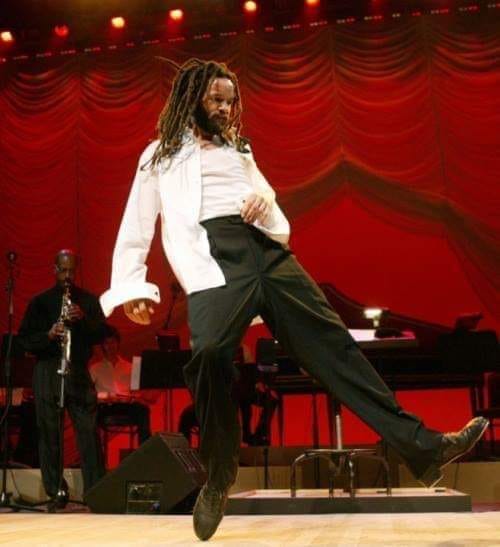Savion Glover was born on this date in 1973. He is an African American actor, tap dancer, and choreographer.Glover was born in Newark, N.J., where as a young child he displayed an enthusiasm for rhythms and at age four he began taking drumming lessons. At age seven he began taking tap lessons and quickly developed a passion for rhythm tap, a form that uses all parts of the foot to create sound. Glover is a graduate of the Newark Arts High School.Glover’s great grandfather on his mother’s side, Dick (King Richard) Lundy, was a shortstop in the Negro Leagues. He managed eleven Negro League baseball teams, including the Newark Eagles. His grandfather, Bill Lewis, was a big band pianist and vocalist.His grandmother, Anna Lundy Lewis, was the minister of music at New Hope Baptist Church in Newark, NJ. She played for Whitney Houston when she was singing in the gospel choir. Anna Lundy Lewis was the one who first noticed Savion’s musical talent. She once held him and hummed some rhythms to him, and he smiled and joined along.Savion states his style is “young and funk.” When asked to describe what funk is, he says it is the bass line. “Funk is anything that gets one’s head on beat. It is riding with the rhythm. It is a pulse that keeps one rolling with the beat.”Gregory Hines, a tap legend, was one of Glover’s tap teachers. Hines stated that “Savion is possibly the best tap dancer that ever lived.” Savion likes to start his pieces with some old school moves from famous tappers and then work his way into his own style. Hines says it’s like paying homage to those he respects. When Honi Coles died, Savion performed at his memorial service. He finished his dance with a famous Coles move, a backflip into a split from standing position, then getting up without using one’s hands. Savion rarely does this move because it wasn’t his style, but he did it because it was Coles’ style that Savion wanted to keep alive. “I feel like it’s one of my responsibilities to keep the dance alive, to keep it out there, to keep the style.”Henry LeTang called Glover “the Sponge,” because he learns very quickly with everything that is thrown at him. LeTang taught the Hines brothers back in the 1950s and taught Glover for a little while before having him work for “Black and Blue,” a tap revue in Paris in 1987. Many legendary tappers taught Glover such as LeTang, the Hines brothers, Jimmy Slyde, Chuck Green, Lon Chaney (Isaiah Chaneyfield), Honi Coles, Sammy Davis, Jr., Buster Brown, Howard Sims, and Arthur Duncan.While a student at Broadway Dance Center in Manhattan, his teacher arranged an audition for him with a Broadway choreographer. This led to his Broadway debut at age 10 in “The Tap Dance Kid.” He made his film debut in 1989’s “Tap” co-starring with Gregory Hines and Sammy Davis Jr. In 1990, he joined the cast of the children’s television series, “Sesame Street.”He came to additional public attention in 1996, starring in the George C. Wolfe-produced musical “Bring in ‘da Noise/Bring in ‘da Funk” for which he won the 1996 Tony award. He also starred in Spike Lee’s 2000 film “Bamboozled.” In 2004, Glover partnered with spoken word artist Reg E. Gaines and saxophonist Matana Roberts in a John Coltrane-inspired improvisation session, “If Trane Wuz Here.”Savion has danced on concert stages throughout the world, including the Moulin Rouge, Lincoln Center, and Carnegie Hall. He choreographed a work for the Washington Society for the Performing Arts in association with the NEA and has received an Endowment Grant for Choreography, making him the youngest person in NEA history to receive this honor. He has won numerous other awardsIn 2005, he collaborated with a string chamber orchestra and his band, “The Otherz,” in “Classical Savion”. He is the motion-capture dancer for Mumble, the penguin in the Warner Bros. animated release “Happy Feet.”Shuffle Along, or, the Making of the Musical Sensation of 1921 and All That Followed (2016).Glover choreographed this musical, which opened in 2016 at the Music Box Theatre. He has been nominated for a Tony Award for Best Choreography and a Drama Desk Award for his work on the musical.
Written by Dianne Washington

